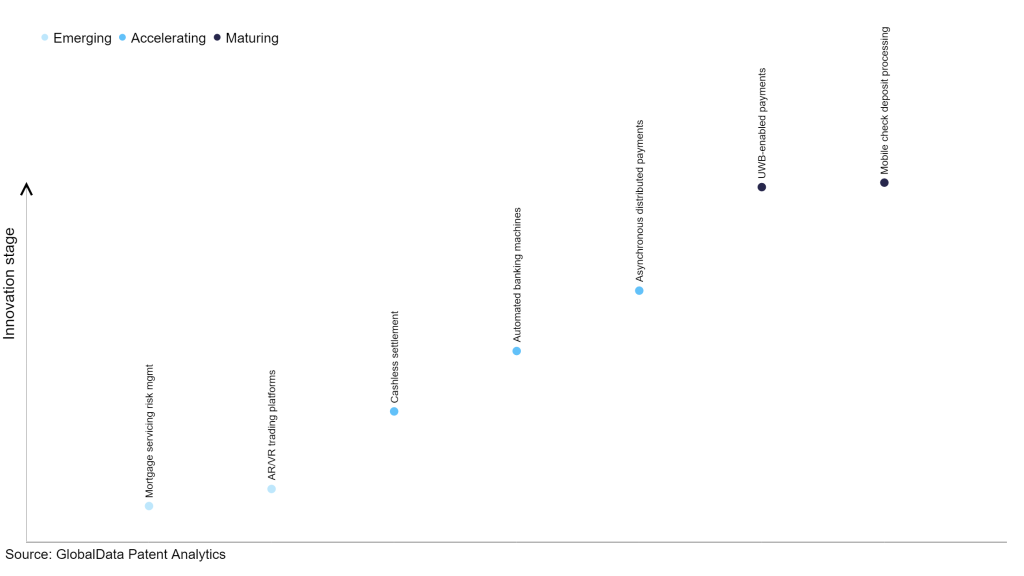The banking industry continues to be a hotbed of patent innovation. Activity is driven by digitalization, enhanced security, operational efficiency, ever changing consumer expectations, and growing importance of technologies such as artificial intelligence (AI), Internet of Things (IoT), and cyber security. In the last three years alone, there have been over 5,000 patents filed and granted in the banking industry, according to GlobalData’s report on Innovation in banking: asynchronous distributed payments. Buy the report here.
However, not all innovations are equal and nor do they follow a constant upward trend. Instead, their evolution takes the form of an S-shaped curve that reflects their typical lifecycle from early emergence to accelerating adoption, before finally stabilizing and reaching maturity.
Identifying where a particular innovation is on this journey, especially those that are in the emerging and accelerating stages, is essential for understanding their current level of adoption and the likely future trajectory and impact they will have.
35+ innovations will shape the banking industry
According to GlobalData’s Technology Foresights, which plots the S-curve for the banking industry using innovation intensity models built on over 176,000 patents, there are 35+ innovation areas that will shape the future of the industry.
Within the emerging innovation stage, mortgage servicing risk management and AR/VR trading platforms are disruptive technologies that are in the early stages of application and should be tracked closely. Cashless settlement, automated banking machines, and asynchronous distributed payments are some of the accelerating innovation areas, where adoption has been steadily increasing. Among maturing innovation areas are UWB-enabled payments, and mobile check deposit processing, which are now well established in the industry.
Innovation S-curve for the banking industry

Asynchronous distributed payments is a key innovation area in banking
Asynchronous distributed payments refer to a method of paying for goods or services where the payment and authorization messages are sent separately, and the payment is credited to the account once the transaction has been authorized. The payment process involves issuing a membership account number to the user, receiving a payment from the user at a point-of-sale, generating an authorization message including the membership account number and transaction information, communicating the information to a database server, and crediting the customer account based on the transaction information.
GlobalData’s analysis also uncovers the companies at the forefront of each innovation area and assesses the potential reach and impact of their patenting activity across different applications and geographies. According to GlobalData, there are 1,525+ companies, spanning technology vendors, established banking companies, and up-and-coming start-ups engaged in the development and application of asynchronous distributed payments.
Key players in asynchronous distributed payments – a disruptive innovation in the banking industry
‘Application diversity’ measures the number of applications identified for each patent. It broadly splits companies into either ‘niche’ or ‘diversified’ innovators.
‘Geographic reach’ refers to the number of countries each patent is registered in. It reflects the breadth of geographic application intended, ranging from ‘global’ to ‘local’.
Patent volumes related to asynchronous distributed payments
Source: GlobalData Patent Analytics
Among the companies innovating in asynchronous distributed payments, Visa is one of the leading patent filers. The company filed patents related to secure remote token release with online authentication, point-of-sale (POS) network systems, methods of authenticating and processing secure transactions using a mobile device, and business-to-business electronic payment processing apparatus, methods, and systems. Toshiba, Mastercard, and Block are some of the other key patent filers in the asynchronous distributed payments space.
In terms of application diversity, Headwater Partners I held the top position, while Headwater Research and Nant Ip stood in second and third positions, respectively. By means of geographic reach, Nant Ip leads the pack, followed by Headwater Partners I and AB Dynamics.
To further understand the key themes and technologies disrupting the banking industry, access GlobalData’s latest thematic research report on Banking.
Data Insights
From

The gold standard of business intelligence.
Blending expert knowledge with cutting-edge technology, GlobalData’s unrivalled proprietary data will enable you to decode what’s happening in your market. You can make better informed decisions and gain a future-proof advantage over your competitors.







